Trade was an essential contributor to the overall economic growth of Ancient Rome. Trade flourished in Ancient Rome towards the end of the Roman Kingdom during the Republic period around 509 BC.
The Roman Empire was established during the Imperial period. After its establishment in 27 BC, Trade became a predominant source of the Roman economy throughout most of its existence.
What helped to establish Trade in Ancient Rome?
Content
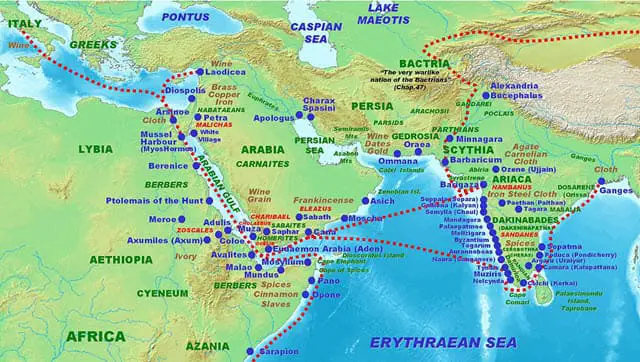
Source: Wikimedia Common
Ancient Romans lived across the Italian Peninsula. However, the Roman Empire extended from Portugal to Persia and Scotland to the Sahara Desert, one of the oldest civilizations.
The territory expanded to today’s European countries such as Spain, England, Wales, Germany, Switzerland, the Czech Republic, Slovenia, Austria, Croatia, Belgium, and the Netherlands. More significant parts of Poland, France, and Italy also were parts of the Holy Roman Empire.
Similarly, it extended to the coastal parts of Northern Africa up to countries such as Egypt and Libya. The extension continued up to the Balkans, including countries like Greece, Hungary, Turkey. The Mediterranean Sea, the Black Sea, Asia Minor were essential parts of the Roman Empire.
The Middle East, including countries like Syria, Iraq, Jordan, was also part of the Roman Empire. Thus, the Roman Empire had plenty of land and sea routes that facilitated Trade and helped flourish it to a great extent.
The expansion of the Roman territory into the Holy Roman Empire contributed to the development of Trade in Ancient Rome. As a result, the Roman Empire had plenty of both land and sea routes. Sea routes comprised the Mediterranean and the Black Sea.
The land routes were constructed across the Holy Roman Empire. Ancient Romans built about 83,000 kilometers of paved roads stretching from Scotland and passing Eastern Europe to Iraq, ending in Northern Africa.
The roads were constructed with long-lasting materials that formed systematically engineered highways that could resist traffic and exposure to several atmospheric changes. As a result, the amount of Trade increased.
How Trade Contributed to the Economy of Ancient Rome?
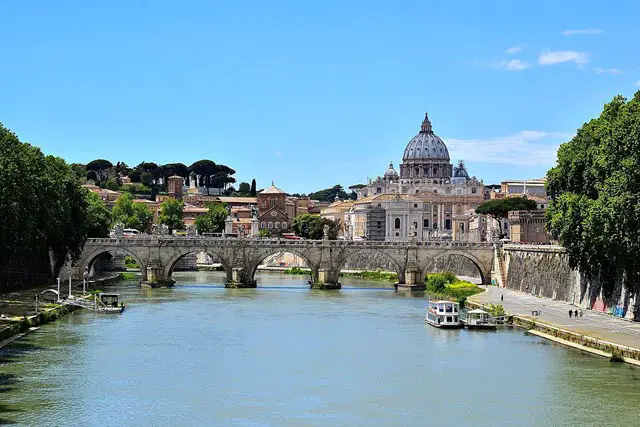
Source: Wikimedia Common
Before the Imperial period, the Roman economy was based primarily on Agriculture and Animal Husbandry. Ancient Rome had limited areas of plain lands that were farmable due to various mountain ranges passing through the area.
As a result, they adapted by rearing animals that need little space to survive, such as sheep, goats, and pigs. They planted crops that required little water to grow, such as barley, wheat, and fruits such as grapes and oranges.
The Tiber River provided the necessary water resource for irrigation. Towards the beginning of the Imperial Period, technological advancements in Ancient Rome led to farming tools made up of iron, and farming was done more efficiently.
The production of a surplus of barley, wheat, olive, grapes, and oils increased Rome’s population. Local Trade started within areas of Rome. Ancient Rome became a large city inhabiting a population of more than a million.
The population inhabiting other parts of the Roman Empire consisting of more than 2000 cities could be counted as more than several hundreds of thousands. Trade was established as a fundamental economic concept in Ancient Rome. It helped people across the Roman Empire sell those goods in abundance and buy those goods they could not grow or produce.
Trade excelled during the Imperial period in Ancient Rome during the formation of the Holy Roman Empire. It was because a vast sum of money was required to run and operate the entire expanded territory.
Routes for Trade in Ancient Rome
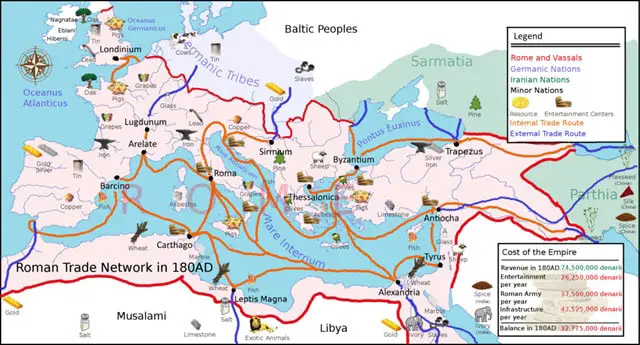
Source: Wikimedia Common
The beginning of Inter-Regional Trade can be traced to Ancient Rome, when it was established as the Capital of the Imperial Period. The inhabitants of Rome were fed by the grains imported from Egypt, Africa, and Crimea.
The trading partners were spread across Spain, France, the Middle East, and North Africa. When grains began being imported to Rome, there was still a demand for vegetables, beef, olives, wine, and dairy products.
The countryside near Rome was given over to intensive farming to produce highly demanded products in the city of Rome systematically and technically.
Massive ships were sent full of goods from Italy to Carthage in Northern Africa for carrying goods. The nearest major port to Rome was Ostia which was located 25 kilometers away from Rome.
A large number of ships traveled back and forth between Ostia and Carthage in Northern Africa. The Tiber River created a deep water passage to the city of Rome that made sea trade even more accessible. Roman cities such as Alexandria and Antioch also had major seaports.
The majority of Trade in Ancient Rome happened through the wide Trade networks established in the Mediterranean sea. The journey elongated up to a distance of about 1000 kilometers on the Nile river. It took no less than two weeks, even when the ships continuously traveled day and night.
The Romans built lighthouses, harbors, and docks to make travel safe. The Pharos Lighthouse in Alexandria was built during the Imperial Period, which is flame-toped.
It is one of the Seven Wonders of the World, made in Ancient Rome to make sea journeys easier. Ancient Roman traders gave sea journeys utmost importance because shipping was cheaper than sending products through land routes.
Condition of Trade in Ancient Rome
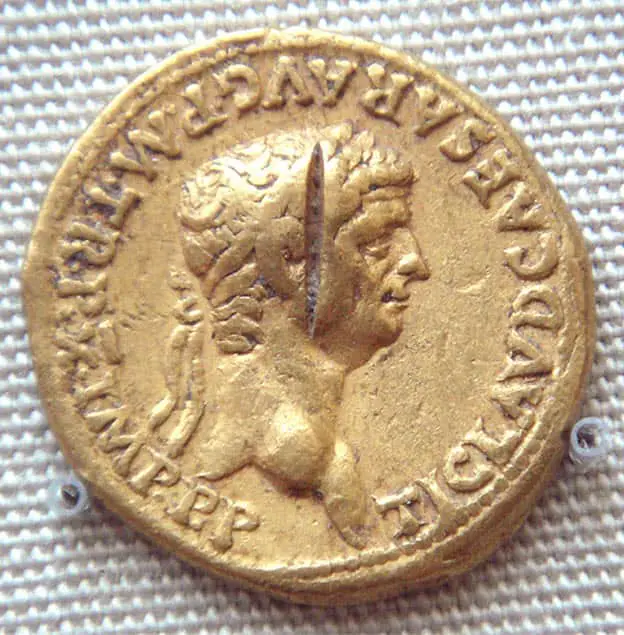
Source: Wikimedia Common
Ancient Romans had formulated excellent policies that facilitated Trade. The usage of the same currency and the absence of provisions regarding complex custom taxes across the Empire were policies developed in the Roman Empire.
Ancient Roman artisans crafted coins with such details that it was tough to be replicated. Their numbering system, popularly known as Roman Numerals, was one of the most known Roman inventions to keep records and accounts of goods and money.
Ancient Romans imported metals like iron, silver and lead, olive oil from Spain and Africa. They also imported wheat and marble from Egypt, which was carried by ships across the Mediterranean sea.
Trade with Britain was made both in the form of Import and Export. Britain exported lead, woolen products, and tin to Rome, and in exchange, it imported from Rome wine, olive oil, pottery, and papyrus. British traders depended on the Romans to provide security within the Holy Roman Empire.
The development of International Trade in Ancient Rome led to an advanced trade route with China. Silks, rich brocades, cloths made of gold, and jeweled embroideries made their way to Rome from China.
Ships loaded with perfumes from Arabia, spices and rare woods from India, and silk from China passed through Palmyra in Syria and several other towns and made their way to the Roman Empire.
Even though Trade was an essential contributor to the economy of Ancient Rome, it would be challenging for Traders to engage in the process due to the presence of geographical drawbacks.
The situation of Rome in between mountain ranges led to the creation of atmospheric hurdles to carry out Trade. Dependency on sea routes risked the chances of damaged goods and loss of lives due to natural calamities.
Rome was close to rivers, and there was a constant risk of flood, and sometimes trade routes were blocked due to floods. However, territorial expansion, military development, and political supremacy contributed to the prosperity of Trade in Ancient Rome.
The Impact of Mixed Economic System on Trade in Ancient Rome
Trade was made in three levels in Local, Inter-regional, and International levels in Ancient Rome. The mixed economic system was practiced in Ancient Rome.
There was the presence of both the intervention of government along with the free-market economy. Goods produced could be exported to other places as per producers’ will, but State ensured whether good goods were being delivered.
As Trade prospered across the Roman Empire, State Control increased to ensure Supply as per the Demand of goods. State intervention increased as the scale of Trade increased to ensure that genuine products were shipped.
State monitored whether the promised quantity and weight were delivered and assured if the quality was maintained. Goods began to be stamped and sealed so that replication was not possible.
The State would appoint an official to regulate the associations of ship owners engaged in Trade. Taxes began to be imposed for the movement of goods. Moreover, weekly markets and fare markets were also regulated by the State.
In Ancient Rome, when Trade was at its peak, the level of State intervention increased. However, the State still allowed the presence of a free market, and Trade was also conducted independently from the interference of the State.
During the same time, the concept of Banking was developing, which enabled independent Trade. Merchants took loans in one port and paid them off in other seaports when they profit by selling goods.
Traders could obtain the finances they needed to buy goods through maritime loans, in which the cargo was pledged as a security. The interest payments were up to 30 percent. The loans would only be repaid after the cargo arrived with goods.
However, they could also lose money if the ships did not arrive. Traders took risks because the profits would be very high if the ships arrived, and they would recover from the losses sooner or later.
The Roman Empire also allowed certain territories beyond the periphery of the cities to have free markets and an independent Trade system.
Gradual progression of Trade in Ancient Rome
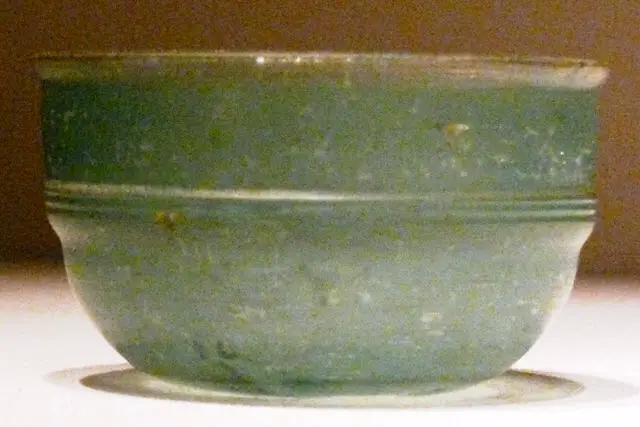
Source: Wikimedia Common
The dominance of agricultural products on Trade could be observed in the Roman economic structure due to lower capitals invested in industrial sectors. It was mainly because of the somewhat negative attitude of Ancient Romans belonging to Higher classes towards Trade.
Ownership of land and engagement in irrigational activities was considered a sign of wealth, but production of goods and Trade was supposed to be for lower classes. The people that belonged to the higher ranks that invested in manufacturing goods and were involved in Trade would often employ slaves and agents to perform the duties.
It progressed around the 2nd century BCE when more significant investments were made in industrial sectors, leading to various goods. As a result, the dependency of Trade on Agriculture became a little less dominant.
After the full-fledged establishment of Trade in the Roman Empire, the development of the city of Rome knew no bounds. The imports of goods developed the infrastructures of Rome, the quality of life of the people, and increased the social status of high-class people. They became more economically prosperous.
Slave culture was very much prominent in Ancient Rome. Slavery played an important role in society and the economy because slaves worked in farms, mills, mines and produced many goods for the higher class.
They built buildings, houses, monuments that are of great importance even in the present society. As we know it today, Italy and other parts of the Roman Empire still have the reputation of roads and monuments built in Ancient Rome.
Analysis
The sheer volume of Trade in the Roman Empire made it regarded as one of the most developed financial systems in the Ancient World. The magnitude and scale of Trade delivered by the Ancient Romans during the Imperial Period could not be met until the advent of Industrialization in the 19th century.
The establishment of Trade had a direct impact on the existence of the Holy Roman Empire for a period of more than a thousand years. When the Holy Roman Empire started to fall apart, Trade across the expanded territory collapsed.
In a nutshell, the concept of Trade flourished gradually in Ancient Rome. The Pre-Republican period in Ancient Rome was vital to the prosperity of Trade. The formation of land routes and the expansion of Rome into the Holy Roman Empire led to the formation of various sea routes upon which Trade was heavily dependent.
Initially, Trade was limited only to agricultural products, which gradually decreased with people’s investment in the production of goods.
Conclusion
Thus, the presence of a Mixed Economic system in the Imperial period formed an ideal economic system that paved the way for the progress of Trade. The Roman Empire was so developed in terms of Trade that no other pre-industrial society before the 19th century could compete with the caliber delivered by Trade in Ancient Rome.
It made Rome economically strong and developed the living standard of people across the Roman Empire. Romans led a luxurious life. The import and export of agricultural products in a large quantity had diminished the problem of hunger and starvation. There would rarely be a scarcity of essential food items in the Roman Empire. Trade was undoubtedly the backbone of the economic status of Ancient Rome.

Yeah, trade flourished in Ancient Rome but where was the requisite consumer purchasing power of goods and services if the people producing the products were slaves?